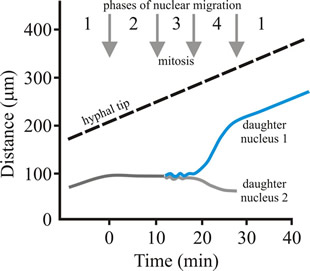4.8 Regulation of nuclear migration
In fungi, nuclei are sufficiently motile to migrate through the hypha, and the spatial distribution of nuclei in a mycelium is determined by their migratory behaviour. The migratory cycle of nuclei (of the basidiomycete Polystictus versicolor) has been divided into four phases (Fig. 15):
- In the prolonged first phase most of the cell contents (nuclei, mitochondria, vacuoles, vesicles and various granules) move towards the hyphal apex at about the same rate as the hyphal tip extends, so the distance between the cell contents and the tip remains approximately constant.
- In the second phase, nuclei stop migrating although other cytoplasm components continue to move forward, so the distance between nuclei and the hyphal tip increases.
- Synchronous mitosis occurs of the nuclei (two nuclei in the dikaryotic hyphae of P. versicolor) during the third phase.
- In the fourth and final phase, one of the pair of daughter nuclei moves rapidly towards the apex and at a faster rate than tip extension, so that the nucleus migrates through the hypha to assume the phase 1 migratory distance behind the hyphal apex; whilst the second of the pair of daughter nuclei moves slowly away from the tip.
 |
Fig. 15. Hyphal extension and nuclear migration in dikaryotic apical compartments of Polystictus (= Trametes) versicolor grown at 24°C. The curves are the means of 34 observations. The diagonal dashed line shows the location of the hyphal apex as it extends (upwards) away from the fixed point in space set as position zero. The solid line in the lower part of the figure records the position of one of the (haploid) dikaryotic nuclei located in the terminal compartment. In the prolonged phase one (prior to time zero) the nucleus moves towards the hyphal apex at about the same rate as the hyphal tip extends, so the distance between the two remains approximately constant. At the onset of mitosis (time zero), phase two, the nucleus stop migrating, so the distance between the nucleus and the hyphal apex increases. Synchronous mitosis of the (two) dikaryotic nuclei takes place in that position (phase three) and the hyphal apex continues to extend. We are only tracking one of the two dikaryotic nuclei but mitosis, of course, produces two daughter nuclei, so the line divides into two. In the fourth and final phase, one of the pair of daughter nuclei moves rapidly towards the apex and at a faster rate than tip extension, so that the nucleus migrates through the hypha to assume the phase 1 migratory distance behind the hyphal apex. The second of the pair of daughter nuclei moves slowly away from the tip. Redrawn after Trinci, 1979. |
The generalisation that seems to apply to fungal hyphae commonly is that at a particular point in the mitotic cycle, nuclei stop migrating and undergo mitosis, and by so doing get left behind by the advancing hyphal tip, but after mitosis the daughter nuclei reoccupy their normal position at a regulated distance behind the hyphal apex.
A functional microtubule system is necessary for normal nuclear migration and a considerable cellular apparatus is involved (described in Chapter 5).
Updated July, 2019
